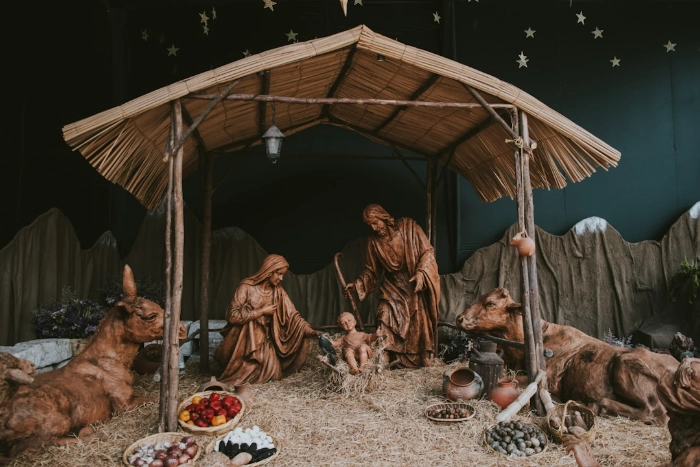It's Christmas, but where does it come from in the bible

The Christmas Narrative in Luke's Gospel
Luke's account of the birth of Christ (Luke 1–2) is rich in theological significance, historical detail, and devotional beauty. The narrative centers on the incarnation of Jesus Christ, emphasizing God's sovereignty, covenantal faithfulness, and grace.
1. The Announcement to Zechariah (Luke 1:5-25)
The Christmas story in Luke begins with the announcement of John the Baptist's birth to Zechariah. John is the forerunner of Christ, fulfilling Malachi’s prophecy of one who would prepare the way for the Lord.
This highlights God's redemptive plan unfolding in history. John’s role is part of God’s sovereign design to prepare hearts for Christ, demonstrating God’s meticulous providence.
2. The Annunciation to Mary (Luke 1:26-38)
The angel Gabriel announces to Mary that she will conceive Jesus, the Son of the Most High. The incarnation is central to the Reformed understanding of Christmas:
Sovereign Grace: Mary's selection was an act of God’s sovereign grace. She was not chosen because of her merit but as part of God’s redemptive purpose.
Covenantal Fulfillment: The promise of Jesus as the heir to David’s throne fulfills the Davidic covenant (2 Samuel 7:16), reaffirming God’s faithfulness to His covenant promises.
The Incarnation: The eternal Word (John 1:14) becomes flesh, uniting divine and human natures in one person. This underscores the Reformed emphasis on the necessity of Christ’s humanity for redemption.
3. Mary’s Magnificat (Luke 1:46-55)
Mary's song reflects deep theological truths about God’s character and works:
God’s Sovereignty: Mary praises God for His mighty deeds and the reversal of human pride and power.
Covenant Faithfulness: Mary celebrates God’s faithfulness to His promises to Abraham, linking Christ’s birth to the overarching narrative of salvation history.
4. The Birth of Jesus (Luke 2:1-7)
Luke situates Jesus’ birth within historical events (e.g., Caesar Augustus’ decree), emphasizing the reality of the incarnation in time and space. Reformed theology highlights:
God’s Providence: The decree that led Mary and Joseph to Bethlehem fulfilled Micah 5:2, demonstrating God’s sovereign orchestration of history.
The Humility of Christ: Jesus’ birth in a manger exemplifies the humility of the Savior, who emptied Himself (Philippians 2:7) for humanity's sake.
5. The Announcement to the Shepherds (Luke 2:8-20)
The angelic announcement to the shepherds is a declaration of the gospel:
God’s Glory and Peace: The message of “Glory to God in the highest” reflects the ultimate purpose of redemption: God’s glory. The “peace on earth” signifies reconciliation between God and humanity through Christ.
Inclusivity of the Gospel: Shepherds, often marginalized in society, are the first to hear the good news, underscoring the universality of God’s grace.
6. The Presentation in the Temple (Luke 2:21-40)
Simeon and Anna recognize Jesus as the Messiah, praising God for the fulfillment of His promises:
Light for the Gentiles: Simeon’s prophecy in Luke 2:32 points to the inclusion of the Gentiles, reflecting the Reformed emphasis on the catholicity (universality) of the church.
Salvation through Christ Alone: Simeon declares that salvation is found in Christ, reinforcing the Reformed doctrine of Solus Christus (Christ alone).
Theological Themes from a Reformed Perspective
1. The Sovereignty of God
This sees God’s hand at work in every detail of the Christmas story. From Caesar’s decree to the angelic announcements, God’s sovereign will is accomplished, fulfilling His eternal plan of redemption (Ephesians 1:11).
2. The Covenant of Grace
The birth of Christ is the culmination of the covenant of grace, established with Adam, reaffirmed through Abraham, and fulfilled in Christ. Jesus is the seed of the woman (Genesis 3:15), the true offspring of Abraham (Galatians 3:16), and the heir to David’s throne.
3. The Incarnation and Substitutionary Atonement
The incarnation is essential for redemption. Christ had to be fully God to bear the infinite weight of God’s wrath and fully human to represent humanity. The Christmas narrative sets the stage for Christ’s atoning work on the cross.
4. The Glory of God
The ultimate purpose of Christ’s coming is the glory of God. The angelic host proclaims God’s glory, and the entire narrative points to His attributes—His holiness, mercy, and faithfulness.
5. The Humility of Christ
The humble circumstances of Jesus’ birth reflect the kenosis (self-emptying) of the Son of God. This humility is a model for believers and a testament to the depth of God’s love.
6. Joy and Worship
The Christmas story is filled with joy and worship, from Mary’s Magnificat to the angels’ song to the shepherds’ praise. Reformed theology emphasizes the proper response to God’s grace as worship, both in spirit and truth.
Application for Believers
Reformed Christians celebrate Christmas with a focus on the following:
Worship: Recognizing God’s glory and sovereignty, Christmas is a time for heartfelt worship and adoration.
Trust in God’s Providence: The narrative assures believers of God’s control over history and His faithfulness to His promises.
Proclamation of the Gospel: Like the shepherds, believers are called to share the good news of Christ’s birth with others.
Humility and Gratitude: Reflecting on Christ’s humility, Christians are called to live with humility and gratitude for God’s grace.
In summary, the Christmas story in Luke’s Gospel, is a testament to God’s sovereign grace, covenantal faithfulness, and redemptive purposes. It calls believers to marvel at the incarnation, rejoice in salvation, and live for God’s glory.